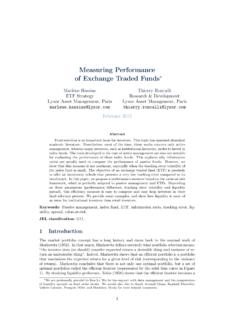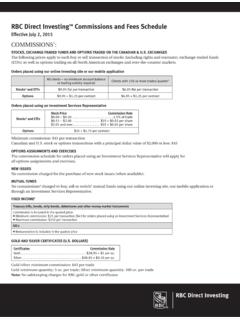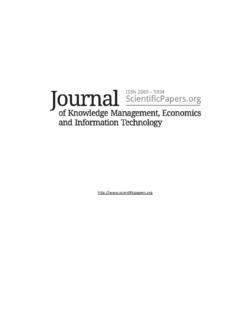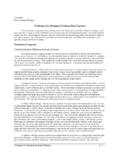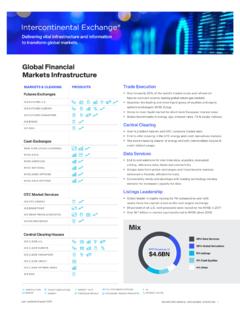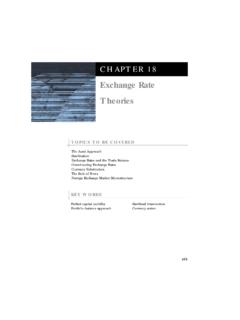Transcription of Foreign exchange turnover in April 2016
1 TriennialCentral bank survey Foreign exchange turnover in April 2016 Monetary and Economic Department September 2016 Annex tables revised on 11 December 2016 Tools to access and download the results of the BIS triennial central bank survey : BIS website tables in PDF of the BIS s most current data BIS Statistics Explorer a browsing tool for pre-defined views of the BIS s most current data BIS Statistics Warehouse a search tool for customised queries of the BIS s most current data Questions about the BIS triennial central bank survey may be addressed to This publication is available on the BIS website ( ). bank for International Settlements 2016. All rights reserved. Brief excerpts may be reproduced or translated provided the source is stated. BIS triennial central bank survey 2016 1 Foreign exchange turnover in April 2016 Contents Notations.
2 2 Abbreviations .. 2 1. BIS triennial central bank survey .. 3 Highlights .. 3 2. turnover in Foreign exchange markets .. 4 turnover by currencies and currency pairs .. 4 turnover by instrument and maturity .. 5 turnover by counterparty .. 7 Geographical distribution of turnover .. 8 Annexes .. 9 A Tables .. 9 B Explanatory notes .. 15 Participating authorities .. 15 Coverage .. 16 turnover data .. 16 Instruments .. 17 Counterparties .. 17 Trading relationships .. 19 Currencies and currency pairs .. 19 Maturities .. 20 Elimination of double-counting .. 20 This publication presents the global results of the 2016 BIS triennial central bank survey of turnover in Foreign exchange markets. A separate publication presents the results of turnover in over-the-counter interest rate derivatives markets ( ). Many participating authorities also publish their national results, links to which are available on the BIS website ( ).
3 The global results for a companion survey on amounts outstanding in OTC derivatives markets will be published in November 2016. Data are subject to change. Revised data will be released concurrently with the BIS Quarterly Review in December 2016. The December 2016 BIS Quarterly Review will include several special feature articles that analyse the results of the 2016 triennial survey . 2 BIS triennial central bank survey 2016 Notations billion thousand million trillion thousand billion e estimated lhs left-hand scale rhs right-hand scale $ US dollar unless specified otherwise.
4 Not available . not applicable nil or negligible Differences in totals are due to rounding. The term country as used in this publication also covers territorial entities that are not states as understood by international law and practice but for which data are separately and independently maintained. Abbreviations ARS Argentine peso LTL Lithuanian litas AUD Australian dollar LVL Latvian lats BGN Bulgarian lev MXN Mexican peso BHD Bahraini dinar MYR Malaysian ringgit BRL Brazilian real NOK Norwegian krone CAD Canadian dollar NZD New Zealand dollar CHF Swiss franc OTH other currencies CLP Chilean peso PEN Peruvian new sol CNY Chinese yuan (renminbi) PHP Philippine peso COP Colombian peso PLN Polish zloty CZK Czech koruna RMB renminbi.
5 See CNY DKK Danish krone RON new Romanian leu EUR euro RUB Russian rouble GBP pound sterling SAR Saudi riyal HKD Hong Kong dollar SEK Swedish krona HUF Hungarian forint SGD Singapore dollar IDR Indonesian rupiah THB Thai baht ILS Israeli new shekel TRY Turkish lira INR Indian rupee TWD new Taiwan dollar JPY yen USD US dollar KRW Korean won ZAR South African rand BIS triennial central bank survey 2016 3 1. BIS triennial central bank survey The BIS triennial central bank survey is the most comprehensive source of information on the size and structure of global Foreign exchange (FX) and over-the-counter (OTC) derivatives markets. The triennial survey aims to increase the transparency of OTC markets and to help central banks, other authorities and market participants monitor developments in global financial markets.
6 It also helps to inform discussions on reforms to OTC markets. FX market activity has been surveyed every three years since 1986, and OTC interest rate derivatives market activity since The triennial survey is coordinated by the BIS under the auspices of the Markets Committee (for the FX part) and the Committee on the Global Financial System (for the interest rate derivatives part). It is supported through the Data Gaps Initiative endorsed by the G20. The latest survey of turnover took place in April 2016. central banks and other authorities in 52 jurisdictions participated in the 2016 survey (see page 15). They collected data from close to 1,300 banks and other dealers in their jurisdictions and reported national aggregates to the BIS, which then calculated global aggregates. turnover data are reported by the sales desks of reporting dealers, regardless of where a trade is booked, and are reported on an unconsolidated basis, ie including trades between related entities that are part of the same group.
7 Highlights Highlights from the 2016 triennial survey of turnover in OTC Foreign exchange markets: Trading in Foreign exchange markets averaged $ trillion per day in April 2016. This is down from $ trillion in April 2013, a month which had seen heightened activity in Japanese yen against the background of monetary policy developments at that time. For first time since 2001, spot turnover declined. Spot transactions fell to $ trillion per day in April 2016 from $ trillion in 2013. In contrast, the turnover of FX swaps rose further, reaching $ trillion per day in April 2016. This rise was driven in large part by increased trading of FX swaps involving yen. The US dollar remained the dominant vehicle currency, being on one side of 88% of all trades in April 2016. The euro, yen and Australian dollar all lost market share. In contrast, many emerging market currencies increased their share.
8 The renminbi doubled its share, to 4%, to become the world s eighth most actively traded currency and the most actively traded emerging market currency, overtaking the Mexican peso. The rise in the share of renminbi was primarily due to the increase in trading against the US dollar. In April 2016, as much as 95% of renminbi trading volume was against the US dollar. The share of trading between reporting dealers grew over the three-year period, accounting for 42% of turnover in April 2016, compared with 39% in April 2013. Banks other than reporting dealers accounted for a further 22% of turnover . Institutional investors were the third largest group of counterparties in FX markets, at 16%. In April 2016, sales desks in five countries the United Kingdom, the United States, Singapore, Hong Kong SAR and Japan intermediated 77% of Foreign exchange trading, up from 75% in April 2013 and 71% in April 2010.
9 1 More frequent regional surveys are conducted by local Foreign exchange committees in Australia, Canada, London, New York, Singapore and Tokyo. These semiannual surveys focus on the structure of local FX markets, and there are some methodological differences compared with the triennial survey . In particular, the triennial survey collects data based on the location of the sales desk, whereas some regional surveys are based on the location of the trading desk. 4 BIS triennial central bank survey 2016 2. turnover in Foreign exchange markets According to the 2016 triennial survey , turnover in global FX markets averaged $ trillion per day in 2016 (Table 1). This is down from $ trillion in April 2013, a month which had seen heightened activity in Japanese yen against the background of monetary policy developments at that In addition, exchange rate movements influence comparisons with previous surveys.
10 In particular, the appreciation of the US dollar between 2013 and 2016 reduced the US dollar value of turnover in currencies other than the US dollar. When valued at constant ( April 2016) exchange rates, turnover increased slightly, by about 4% between April 2016 and April 2013 (Table 1). Nevertheless, the latest developments contrast with the strong growth in turnover observed between triennial Surveys since 2001. turnover by currencies and currency pairs The US dollar remained the world s dominant vehicle currency. It was on one side of 88% of all trades in April 2016, up slightly from 87% in April 2013 (Graph 1, left-hand panel). In contrast, trading in the next eight most liquid currencies has shifted notably. The role of the euro in FX markets has continued to decline since the beginning of the euro area sovereign debt crisis in 2010. The market share of the currency declined to 31% in April 2016 from 33% in April 2013 and 39% in April 2010 (Graph 1, left-hand panel, and Table 2).










